It's shape and choice of home make it easily identified from other crabs. It has one large claw and a secondary smaller one. Two long hair antennae are attached at the head. Only the legs and the front section of the carapace or shell are hard. The abdomen and tail are soft and totally unprotected.
The colouration is a reddish orange or yellow, but the soft abdomen is a dull brown, sometimes greyish brown. The hermit grows up to 3.5in long.
It's home is it's give away. The hermit needs to protect the permanently soft abdomen so it chooses to live in a discarded shell which it carries around on it's back all the time. Young hermits pick dog whelks and periwinkle shells initially, but as they increase in size they need to transfer to a larger shell, usually a common whelk shell.
This exchange of home is the most dangerous part of the hermits life, for it needs to first check out that the potential new home is not already lived in, then expose it's soft abdomen for a few brief seconds while it moves house. This is when it's most vulnerable to passing fish and it will need to change homes about a dozen times in it's life cycle.
When danger threatens, the hermit can fully withdraw in to the shell leaving only the end of the big claw exposed which it defends itself with.
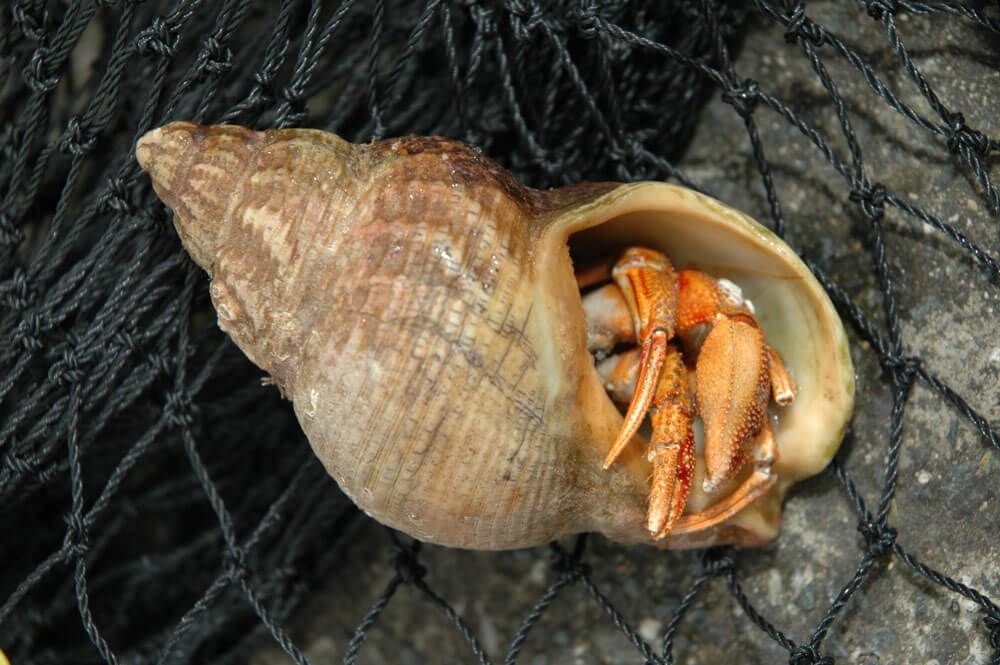
HABITAT
Hermits are common throughout the British Isles. They are most common over clean sandy seabeds, around flattened mussel beds and close to rocky shores, especially where there are concentrated numbers of discarded periwinkle and whelk shells.
Smaller hermits can be found in shallow pools along the low water line of surf beaches, but more so in the deeper rock pools exposed at low water along a rocky coast.
Other places to find hermits are around bases of piers and man made breakwaters and groynes that have a constant depth of water around them at low tide. Hermits can also show in fair numbers on the sandbanks surrounding estuary mouths.
The larger adult hermits tend to be found some way offshore in deeper water and are attracted to areas of mixed rough where lobster pots are positioned.
SEASON
Hermits can be collected pretty much 12 months of the year in deeper water, but tend to thin out and maybe disappear from the low water of shallow beaches and the low water rock pools during the winters coldest period, but travel only a little way seaward to find more consistent water temperatures.
COLLECTION - SANDY BEACHES
The simplest form of collection is to wait for a good storm to blow up, one that really builds up a surf way out to sea and lasts for a good couple of days. As it dies back, get down on to the beach at the first chance choosing the last two hours of the ebb and low water period.
Walk the tide line and check out any large shells, especially whelk shells to see if there is a hermit at home. It's a good bet there will be. Place these in a small bucket with a few inches of fresh sea water in.
Occasionally, when walking the low tide line on calmer days and also the banks around estuaries, you'll see hermits stranded in shallow tidal pools, sometimes slightly buried in the sand for camouflage.
ROCK POOLS
Hermits are found in some numbers on the bottom of largish rock pools. The knack is not to wade in to the pool and cause ripples which distort your vision through to the pool bottom, but stand back and pick out any tight groups of hermits, or at least form a mental picture of where some of the individuals are. Only then should you wade in and start picking.
It's worth working around any weed fringes and running your hands under the overhangs of small rocks in the pool as the hermits tend to hide away under such structures, especially during the suns highest period in the sky.
Also lift up any flatish stones as hermits also crawl under these, but put the rocks back as you found them.
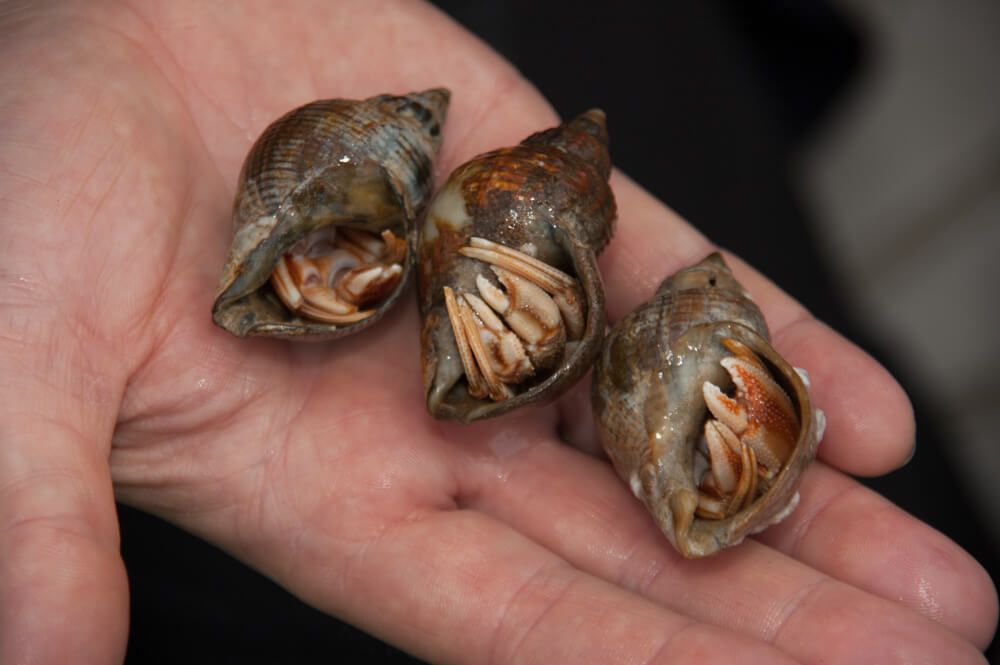
USING A DROP NET
Drop nets are the commonest way to collect hermits. This can be done from piers, breakwaters and other man made structures that give you direct vertical access to the main seabed. A drop net also works well from dinghies and boats.
The best drop nets are the metal ones with a fine mesh, but those with netting also work if the netting squares are small.
You need to make sure that the drop net has enough natural or added weight to make it sit tight on the seabed in a collapsed position. Additional weight is best tied to the centre point of the net on the outside.
Tie some bait, such as a whole mackerel with some slashes in the flank to release some scent, to the centre point of the net on the inside. It's now simply a matter of dropping the net to the seabed below on a long rope and leaving it for about 30 minutes, by which time, if you've chosen your mark well, the bait should be crawling with hermits that have moved in to feed. When you haul the net, do so quickly and keep the net coming upwards at all times. Place the crab in to buckets of fresh sea water for keeping whilst fishing.
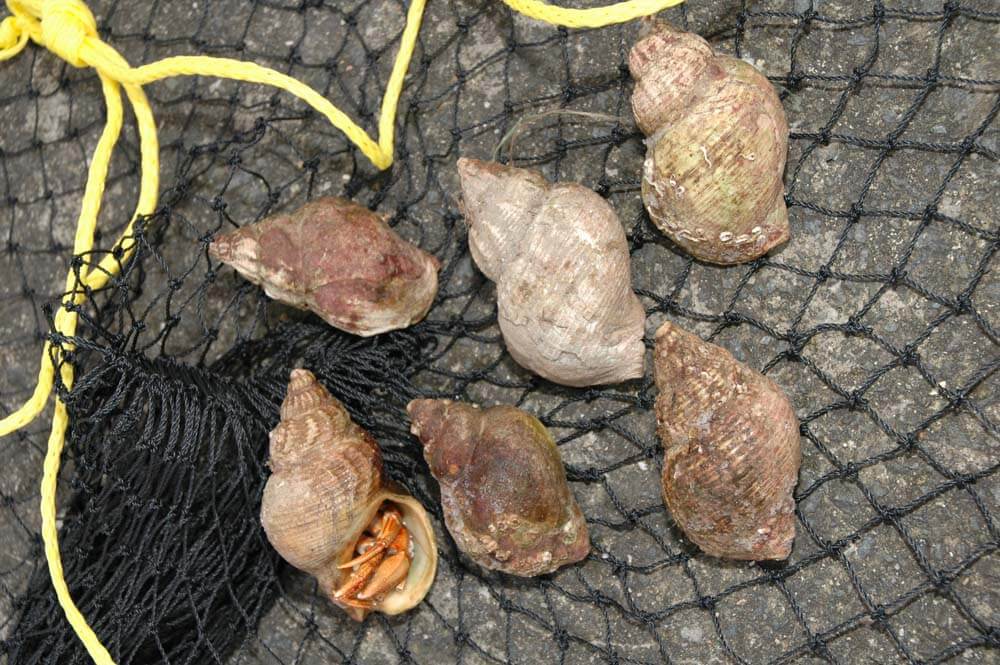
The same method works off the boats, but you're dependent on the run of tide over the mark. It's best to drop the nets half an hour each side of the slack water period, especially in deeper water areas and make sure the net is heavily weighted and secured properly to the boat.
Commercial trammel netters also drag up large numbers of hermits and for the sake of asking, they'll fill a bucket for you saving valuable fishing time.
REMOVING HERMITS FROM THEIR SHELL
The knack to easily removing a hermit from it's shell for bait, or more permanent storage, is to place a live hermit straight in to a container of fresh water. This dramatic change in salinity levels forces the crab out of it's shell almost instantly.
Inferior methods include warming the base of the hermits shell with a cigarette lighter, or gently tapping the shell with a toffee hammer until it cracks and the crab can be prized free.
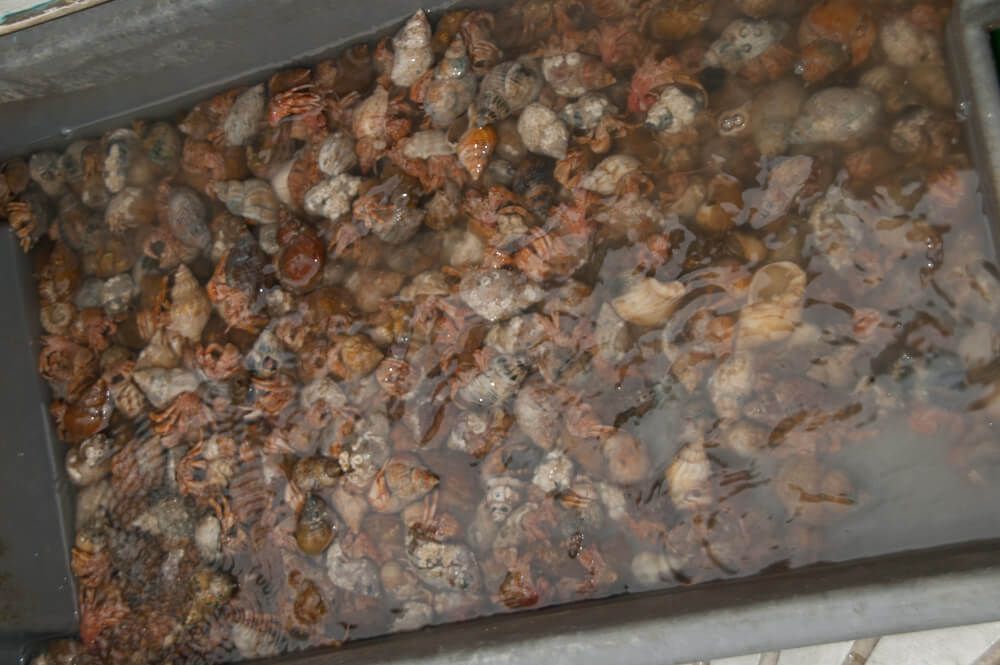
STORAGE
Hermits don't live very long out of water, just a matter of a couple of hours on average, even in a bucket of sea water that gets frequently changed. Ideally, you need to collect hermits at the start of a fishing trip and use them straight away. On the other hand, hermits freeze very well.
Start by placing the live hermits in freshwater to make them vacate the shells. Pack them separately, either wrapping them in cling film, or placing them in to the small sealable plastic envelopes you put rigs in to, then placing them straight in to the fast freeze compartment of your freezer in plastic ice cream containers so that they do not get crushed during the freezing process.
They last for up to 6 months at least like this and prove an excellent stand by bait.
Carry the hermits frozen in a Coleman type cool box with ice packs placed on the top and take them out one at a time as they quickly thaw once in the open atmosphere.
PRESENTATION
You can use a single hermits soft body for flatfish etc, simply sliding it over the hook, or use several bodies and just lightly bind them on with sheering elastic to form a more bulky scent laded bait.
Generally though, bigger fish prefer the whole crab mounted with the soft body near the hook point and the claws bound up the shank of the hook. Don't worry about making a bigger bunch up of two or three hermits when fishing deeper water close to rough ground. It may not look very natural, but it catches fish.
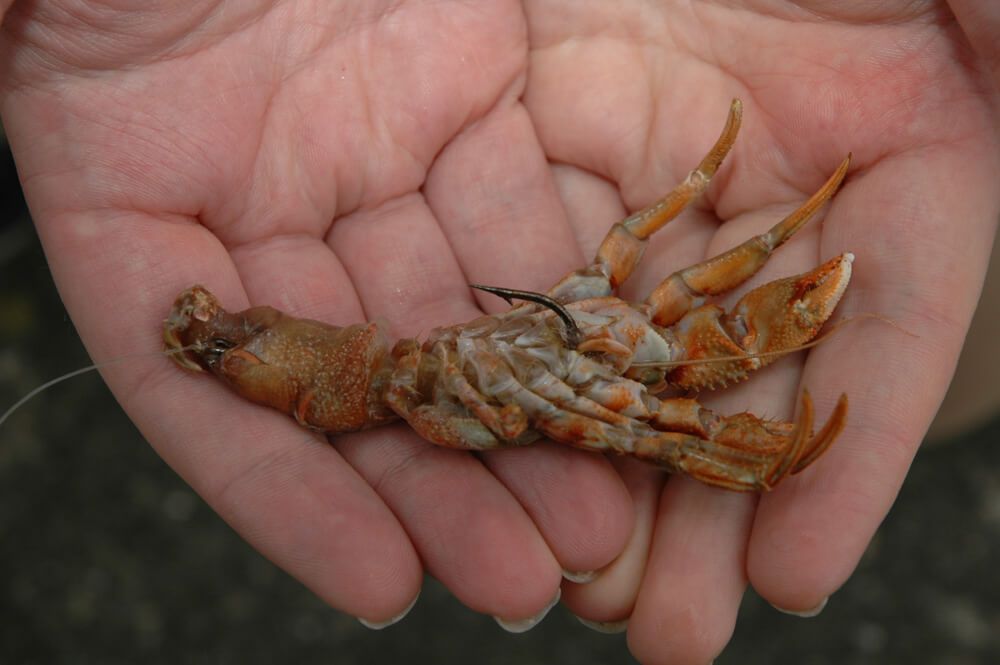
EXPECTED SPECIES
Flounders, plaice, dabs, whiting, dogs, bass, codling and gurnards will all take single or bunched soft bodies.
In deeper water, expect whole crab baits to sort out rays, cod, dogfish, and especially huss and smoothhound around reefy ground. Even smaller conger, pollack, coalfish and wrasse take hermit when they stray off the reef and rough on to the edge of cleaner ground.
All in all, hermit crab is not used enough by anglers and can account for excellent catches when used to target fish such as huss, smoothhound and rays.
HERMIT FACTS
Hermits often have a companion in their shells in the form of a small white ragworm (Nereis fucata). This feeds off the debris left by the crab helping to keep the inner shell clean and makes a good bait in itself.
Hermit crab shells also often carry an anemone. This partnership benefits both, the crab eating some of the bits left over from the anemones kill, and in turn food caught by the crab is passed up to and shared by the anemone.
The colouration is a reddish orange or yellow, but the soft abdomen is a dull brown, sometimes greyish brown. The hermit grows up to 3.5in long.
It's home is it's give away. The hermit needs to protect the permanently soft abdomen so it chooses to live in a discarded shell which it carries around on it's back all the time. Young hermits pick dog whelks and periwinkle shells initially, but as they increase in size they need to transfer to a larger shell, usually a common whelk shell.
This exchange of home is the most dangerous part of the hermits life, for it needs to first check out that the potential new home is not already lived in, then expose it's soft abdomen for a few brief seconds while it moves house. This is when it's most vulnerable to passing fish and it will need to change homes about a dozen times in it's life cycle.
When danger threatens, the hermit can fully withdraw in to the shell leaving only the end of the big claw exposed which it defends itself with.

HABITAT
Hermits are common throughout the British Isles. They are most common over clean sandy seabeds, around flattened mussel beds and close to rocky shores, especially where there are concentrated numbers of discarded periwinkle and whelk shells.
Smaller hermits can be found in shallow pools along the low water line of surf beaches, but more so in the deeper rock pools exposed at low water along a rocky coast.
Other places to find hermits are around bases of piers and man made breakwaters and groynes that have a constant depth of water around them at low tide. Hermits can also show in fair numbers on the sandbanks surrounding estuary mouths.
The larger adult hermits tend to be found some way offshore in deeper water and are attracted to areas of mixed rough where lobster pots are positioned.
SEASON
Hermits can be collected pretty much 12 months of the year in deeper water, but tend to thin out and maybe disappear from the low water of shallow beaches and the low water rock pools during the winters coldest period, but travel only a little way seaward to find more consistent water temperatures.
COLLECTION - SANDY BEACHES
The simplest form of collection is to wait for a good storm to blow up, one that really builds up a surf way out to sea and lasts for a good couple of days. As it dies back, get down on to the beach at the first chance choosing the last two hours of the ebb and low water period.
Walk the tide line and check out any large shells, especially whelk shells to see if there is a hermit at home. It's a good bet there will be. Place these in a small bucket with a few inches of fresh sea water in.
Occasionally, when walking the low tide line on calmer days and also the banks around estuaries, you'll see hermits stranded in shallow tidal pools, sometimes slightly buried in the sand for camouflage.
ROCK POOLS
Hermits are found in some numbers on the bottom of largish rock pools. The knack is not to wade in to the pool and cause ripples which distort your vision through to the pool bottom, but stand back and pick out any tight groups of hermits, or at least form a mental picture of where some of the individuals are. Only then should you wade in and start picking.
It's worth working around any weed fringes and running your hands under the overhangs of small rocks in the pool as the hermits tend to hide away under such structures, especially during the suns highest period in the sky.
Also lift up any flatish stones as hermits also crawl under these, but put the rocks back as you found them.

USING A DROP NET
Drop nets are the commonest way to collect hermits. This can be done from piers, breakwaters and other man made structures that give you direct vertical access to the main seabed. A drop net also works well from dinghies and boats.
The best drop nets are the metal ones with a fine mesh, but those with netting also work if the netting squares are small.
You need to make sure that the drop net has enough natural or added weight to make it sit tight on the seabed in a collapsed position. Additional weight is best tied to the centre point of the net on the outside.
Tie some bait, such as a whole mackerel with some slashes in the flank to release some scent, to the centre point of the net on the inside. It's now simply a matter of dropping the net to the seabed below on a long rope and leaving it for about 30 minutes, by which time, if you've chosen your mark well, the bait should be crawling with hermits that have moved in to feed. When you haul the net, do so quickly and keep the net coming upwards at all times. Place the crab in to buckets of fresh sea water for keeping whilst fishing.

The same method works off the boats, but you're dependent on the run of tide over the mark. It's best to drop the nets half an hour each side of the slack water period, especially in deeper water areas and make sure the net is heavily weighted and secured properly to the boat.
Commercial trammel netters also drag up large numbers of hermits and for the sake of asking, they'll fill a bucket for you saving valuable fishing time.
REMOVING HERMITS FROM THEIR SHELL
The knack to easily removing a hermit from it's shell for bait, or more permanent storage, is to place a live hermit straight in to a container of fresh water. This dramatic change in salinity levels forces the crab out of it's shell almost instantly.
Inferior methods include warming the base of the hermits shell with a cigarette lighter, or gently tapping the shell with a toffee hammer until it cracks and the crab can be prized free.

STORAGE
Hermits don't live very long out of water, just a matter of a couple of hours on average, even in a bucket of sea water that gets frequently changed. Ideally, you need to collect hermits at the start of a fishing trip and use them straight away. On the other hand, hermits freeze very well.
Start by placing the live hermits in freshwater to make them vacate the shells. Pack them separately, either wrapping them in cling film, or placing them in to the small sealable plastic envelopes you put rigs in to, then placing them straight in to the fast freeze compartment of your freezer in plastic ice cream containers so that they do not get crushed during the freezing process.
They last for up to 6 months at least like this and prove an excellent stand by bait.
Carry the hermits frozen in a Coleman type cool box with ice packs placed on the top and take them out one at a time as they quickly thaw once in the open atmosphere.
PRESENTATION
You can use a single hermits soft body for flatfish etc, simply sliding it over the hook, or use several bodies and just lightly bind them on with sheering elastic to form a more bulky scent laded bait.
Generally though, bigger fish prefer the whole crab mounted with the soft body near the hook point and the claws bound up the shank of the hook. Don't worry about making a bigger bunch up of two or three hermits when fishing deeper water close to rough ground. It may not look very natural, but it catches fish.

EXPECTED SPECIES
Flounders, plaice, dabs, whiting, dogs, bass, codling and gurnards will all take single or bunched soft bodies.
In deeper water, expect whole crab baits to sort out rays, cod, dogfish, and especially huss and smoothhound around reefy ground. Even smaller conger, pollack, coalfish and wrasse take hermit when they stray off the reef and rough on to the edge of cleaner ground.
All in all, hermit crab is not used enough by anglers and can account for excellent catches when used to target fish such as huss, smoothhound and rays.
HERMIT FACTS
Hermits often have a companion in their shells in the form of a small white ragworm (Nereis fucata). This feeds off the debris left by the crab helping to keep the inner shell clean and makes a good bait in itself.
Hermit crab shells also often carry an anemone. This partnership benefits both, the crab eating some of the bits left over from the anemones kill, and in turn food caught by the crab is passed up to and shared by the anemone.

